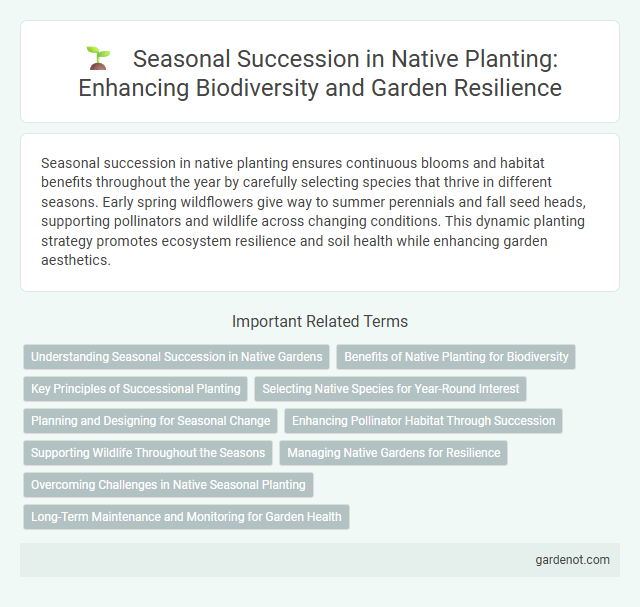Seasonal succession in native planting ensures continuous blooms and habitat benefits throughout the year by carefully selecting species that thrive in different seasons. Early spring wildflowers give way to summer perennials and fall seed heads, supporting pollinators and wildlife across changing conditions. This dynamic planting strategy promotes ecosystem resilience and soil health while enhancing garden aesthetics.
Understanding Seasonal Succession in Native Gardens
Seasonal succession in native gardens ensures a dynamic landscape by selecting plants that bloom, fruit, or display foliage at different times throughout the year. This approach promotes biodiversity and supports local wildlife by providing continuous food and habitat resources during each season. Understanding the natural timing of native species like coneflowers in summer or asters in fall enhances garden resilience and ecological balance.
Benefits of Native Planting for Biodiversity
Native planting promotes seasonal succession by supporting a continuous cycle of growth, flowering, and seeding throughout the year, which sustains diverse wildlife populations. It enhances biodiversity by providing habitat and food sources tailored to local species, fostering pollinators, birds, and beneficial insects. This natural rhythm strengthens ecosystem resilience and contributes to balanced, thriving native habitats.
Key Principles of Successional Planting
Successional planting relies on selecting native species that thrive sequentially throughout the growing season, ensuring continuous ground cover and ecological function. Key principles include prioritizing early-season bloomers to support pollinators, mid-season species for habitat complexity, and late-season plants to sustain wildlife and soil health. This approach enhances biodiversity, soil stability, and ecosystem resilience by mimicking natural plant community dynamics.
Selecting Native Species for Year-Round Interest
Choosing native plants with staggered bloom times ensures continuous seasonal interest and supports local wildlife throughout the year. Incorporate early spring wildflowers like Trillium and Bloodroot, summer bloomers such as Echinacea and Butterfly Milkweed, followed by fall favorites like Aster and Goldenrod to create dynamic habitats. This strategic selection enhances biodiversity, providing food and shelter for pollinators, birds, and beneficial insects during each season.
Planning and Designing for Seasonal Change
Strategic planning for native planting involves selecting species with staggered bloom times to ensure continuous seasonal interest and ecological support. Incorporating early spring bulbs, summer perennials, and late fall seed heads creates a dynamic landscape that sustains pollinators and wildlife throughout the year. Thoughtful design considers soil conditions, sunlight exposure, and plant height to promote healthy growth and visual harmony across changing seasons.
Enhancing Pollinator Habitat Through Succession
Seasonal succession in native planting creates a continuous bloom cycle that supports diverse pollinator populations year-round. By strategically selecting native species with staggered flowering periods, habitats offer consistent nectar and pollen sources critical for bees, butterflies, and other pollinators. This dynamic planting approach enhances ecosystem resilience and promotes biodiversity through sustained pollinator engagement.
Supporting Wildlife Throughout the Seasons
Native planting ensures continuous wildlife support by including a variety of species that bloom and bear fruit at different times, providing essential food and habitat year-round. Seasonal succession creates a dynamic ecosystem where early spring blooms nurture pollinators emerging from winter, while late fall fruit supports migrating birds and mammals preparing for winter. Incorporating native plants with staggered seasonal cycles enhances biodiversity and sustains local wildlife populations across all seasons.
Managing Native Gardens for Resilience
Seasonal succession in native planting ensures continuous bloom and habitat availability by carefully selecting species with staggered flowering and growth periods. Managing native gardens for resilience involves incorporating diverse native plants that support pollinators and wildlife throughout the year, enhancing ecosystem stability. Strategic planting schedules and soil health maintenance promote adaptive responses to climate variability, securing long-term garden vitality.
Overcoming Challenges in Native Seasonal Planting
Native seasonal planting requires careful planning to ensure continuous growth and bloom throughout the year. Overcoming challenges such as unpredictable weather, soil variability, and pest pressure involves selecting diverse, resilient native species adapted to local climate zones. Employing soil amendments and natural pest control methods enhances plant health, supporting sustainable seasonal succession in native gardens.
Long-Term Maintenance and Monitoring for Garden Health
Seasonal succession in native planting requires consistent long-term maintenance and monitoring to ensure garden health and biodiversity. Regular assessments of plant growth, soil quality, and pest presence enable timely interventions that support native species' natural cycles. Implementing adaptive management practices based on seasonal changes promotes resilient ecosystems and sustainable garden landscapes.
Seasonal succession Infographic

 gardenot.com
gardenot.com